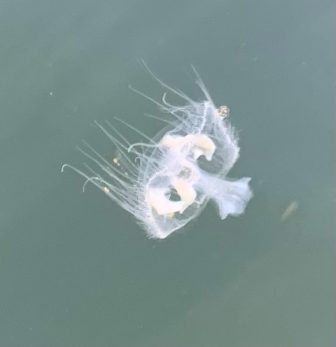
The presence of the peach blossom jellyfish in North America has been on the rise since its arrival in the 1950s. Florian Lüskow, former postdoctoral fellow at The University of British Columbia, began studying the species in 2020 and has observed a northward expansion of the population. Image: Florian Lüskow.
By Kayla Nelsen
Global warming is fueling the spread of a jellyfish in the Great Lakes region and may foster harmful algae blooms and dead zones.
The peach blossom jellyfish is native to warm freshwater in Southeast China, but it is present everywhere around the world except for Antarctica. Since the 1950s, it has been sighted in Lake Erie and Lake Ontario and across Canada.
Peach blossom populations in North America have grown significantly since 2020. The jellyfish is a warm water species, so as water temperatures increase as a result of climate change, northern lakes and ponds become more hospitable to it.
“This has direct implications for the native fish in feeding competition,” said Florian Lüskow, a postdoctoral fellow at the University of British Columbia. “They’re all feeding on more or less the same food sources. And so if they are competing with the jellyfish, this is probably not good.”
The peach blossom jellyfish feeds on organisms that eat algae. Without enough organisms to control it, excessive algae can squeeze out oxygen from lake ecosystems and cause harmful algal blooms and dead zones.
Lüskow predicts that by 2050 the species will have spread northwards to Alaska and the Aleutian Islands.

The peach blossom jellyfish is native to warm freshwater in Southeast China, but is present everywhere around the world except for Antarctica. It likely first came to North America as a boat stowaway during World War II. Image: Tarren Mckay.
“If we continue on this path on which we are right now, we will probably see that the peach blossom jellyfish will become much more apparent, much more frequent and in more lakes longer in the year,” Lüskow said.
Lüskow is one of just a few researchers to study the jellyfish in North America – and that is the problem. There is not yet enough information to understand how to manage the species.
“Our research is pushing the boundaries of what we know,” Lüskow said. “There’s maybe one or two other people in the U.S. who do things that I do. It’s a very small group of people who have all these huge questions.”
Unlike most marine jellyfish, the peach blossom jellyfish does not sting. It is translucent to white and about 1 inch in size. That makes it difficult to spot, Lüskow said.
“It’s a matter of who is around to make an observation,” Lüskow said. “In sparsely populated areas, there are very few people who walk around, have a swim in a nice pond or lake or quarry, and then make this observation to send to a scientific database.”
One solution may be to recruit community members to help scientists understand nonindigenous species. In addition to species identification apps like iNaturalist that connect observations to researchers, people can submit reports to a national database of nonindigenous species through the U.S. Geological Survey.
The peach blossom jellyfish can be found in a Great Lakes-specific species branch of the database called the Great Lakes Aquatic Nonindigenous Species Information System.
“The Great Lakes are absolutely huge, and there are only a handful of researchers in comparison,” said El Lower, the Great Lakes systems communications specialist. “We can’t have eyes everywhere. This is one of the reasons we rely on public reports to get things done. It’s basically adding extra sets of eyes and hands out there.”
Once a form is submitted, a specialist is notified.
“That will trigger this kind of cascading set of reports,” Lower said. “The botanists will get pinged on new plants, the ichthyologists will get pinged on new fish. It saves us time and ensures that the information is going to the right places so that trained experts can take a look and help guide management actions.”
The lack of a response to the spread of the peach blossom jellyfish is due to a lack of observations and subsequent research.

The peach blossom jellyfish is translucent to white in color and is about 1inch in size. It does not sting, unlike most marine jellyfish. Image: Florian Lüskow.
“It’s usually not until there are hundreds and thousands of invasive individuals when people start to wonder if the species is problematic,” Lüskow said. Information transfer between citizens and researchers is an essential next step in uncovering the mysteries of the species for proper management, he said.
“Us researchers are not many in number, but we basically keep pulling our limited resources together to answer important questions about this jellyfish,” Lüskow said.